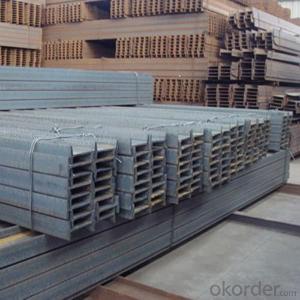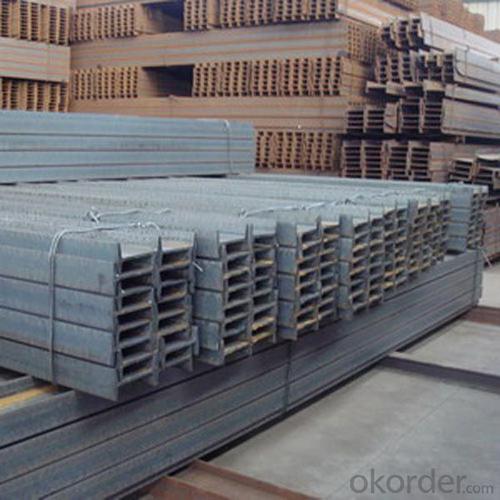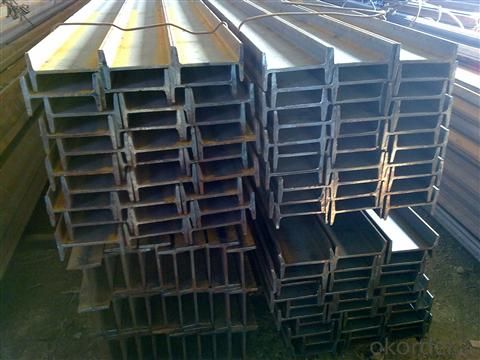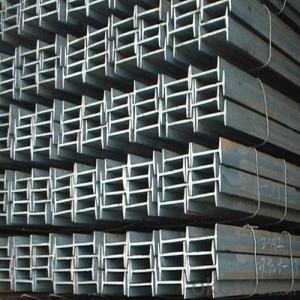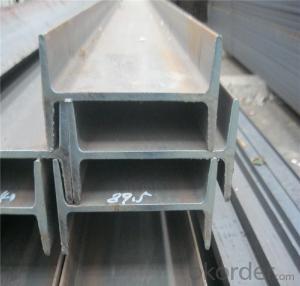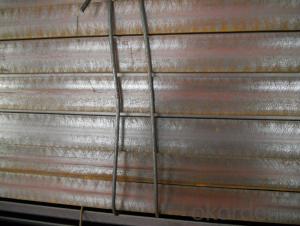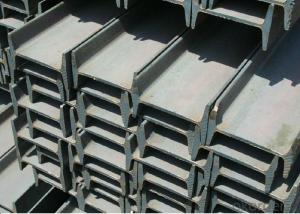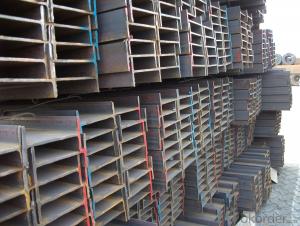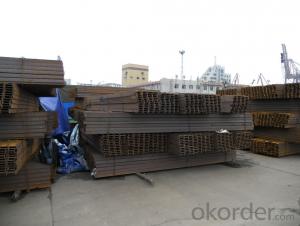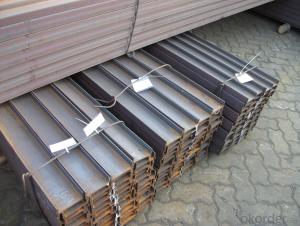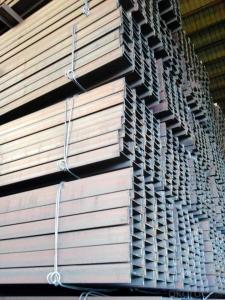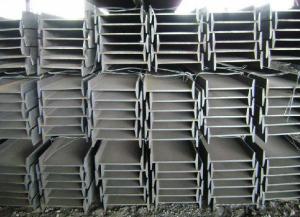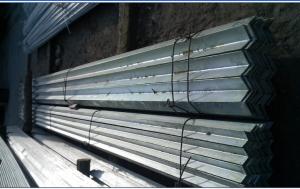80*46mm IPEAA200 ASTM A36 for construction
- Loading Port:
- Tianjin
- Payment Terms:
- TT or LC
- Min Order Qty:
- 25 m.t.
- Supply Capability:
- 100000 m.t./month
OKorder Service Pledge
OKorder Financial Service
You Might Also Like
1. Structure of Steel I Beam IPE Description:
Steel I beam IPE is a beam with an I-shaped cross-section. The horizontal elements of the "I" are known as flanges, while the vertical element is termed the "web". Steel I beam IPE is usually made of structural steel and is used in construction and civil engineering. The Steel I beam IPE resists shear forces, while the flanges resist most of the bending moment experienced by the beam. Steel I beam IPE theory shows that the I-shaped section is a very efficient form for carrying both bending and shears loads in the plane of the web.
2. Main Features of Steel I Beam IPE:
• Grade: Q235
• Type: Mild carbon steel
• Deflection: The stiffness of the I-beam will be chosen to minimize deformation
• Vibration: The stiffness and mass are chosen to prevent unacceptable vibrations, particularly in settings sensitive to vibrations, such as offices and libraries.
• Local yield: Caused by concentrated loads, such as at the beam's point of support.
1. Structure of Steel I Beam IPE Description:
Steel I beam IPE is a beam with an I-shaped cross-section. The horizontal elements of the "I" are known as flanges, while the vertical element is termed the "web". Steel I beam IPE is usually made of structural steel and is used in construction and civil engineering. The Steel I beam IPE resists shear forces, while the flanges resist most of the bending moment experienced by the beam. Steel I beam IPE theory shows that the I-shaped section is a very efficient form for carrying both bending and shears loads in the plane of the web.
2. Main Features of Steel I Beam IPE:
• Grade: Q235
• Type: Mild carbon steel
• Deflection: The stiffness of the I-beam will be chosen to minimize deformation
• Vibration: The stiffness and mass are chosen to prevent unacceptable vibrations, particularly in settings sensitive to vibrations, such as offices and libraries.
• Local yield: Caused by concentrated loads, such as at the beam's point of support.
Package & Delivery of IPE Beam
1. Packing: it is nude packed in bundles by steel wire rod
2. Bundle weight: not more than 3.5MT for bulk vessel; less than 3 MT for container load
3. Marks: Color marking: There will be color marking on both end of the bundle for the cargo delivered by bulk vessel. That makes it easily to distinguish at the destination port.
4. Tag mark: there will be tag mark tied up on the bundles. The information usually including supplier logo and name, product name, made in China, shipping marks and other information request by the customer.
If loading by container the marking is not needed, but we will prepare it as customer request.
5. Transportation: the goods are delivered by truck from mill to loading port, the maximum quantity can be loaded is around 40MTs by each truck. If the order quantity cannot reach the full truck loaded, the transportation cost per ton will be little higher than full load.
6. Delivery of IPE Beam: 30 days after getting L/C Original at sight or T/T in advance
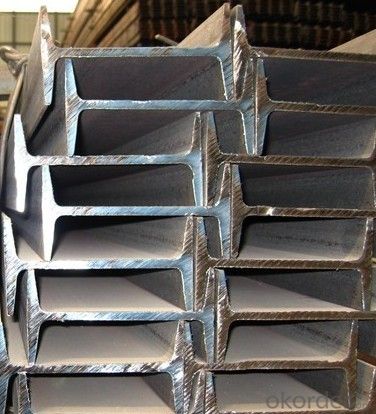
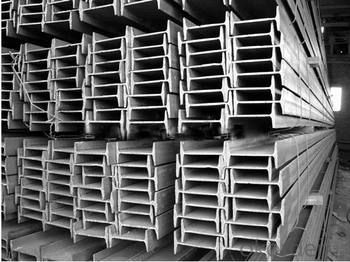
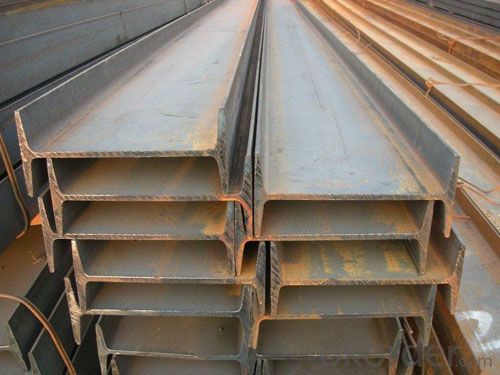
- Q: Can Steel I-Beams be used for basement construction?
- Yes, steel I-beams can be used for basement construction. Steel I-beams are commonly used in construction due to their strength and durability. When it comes to basement construction, steel I-beams are often used as part of the foundation system to support the weight of the structure above. They are particularly useful in basements as they can span long distances without the need for additional support columns, allowing for more open and flexible floor plans. Additionally, steel I-beams are resistant to moisture and pests, making them a suitable choice for basement construction where these factors may be a concern. Overall, steel I-beams are a reliable and popular choice for basement construction due to their structural integrity and ability to provide the necessary support for the building.
- Q: Can steel I-beams be used in hospitals or healthcare facilities?
- Yes, steel I-beams can be used in hospitals or healthcare facilities. Steel I-beams are commonly used in the construction industry due to their strength, durability, and load-bearing capacity. In healthcare facilities, where the safety and integrity of the structure are crucial, steel I-beams can provide the necessary support for the building. They are often used in the construction of floors, walls, and roofs, ensuring the stability of the overall structure. Additionally, steel I-beams are resistant to fire, pests, and weathering, making them a reliable choice for healthcare facilities that require a long-lasting and low-maintenance construction solution.
- Q: Do steel I-beams require any special maintenance?
- Yes, steel I-beams do require regular maintenance to ensure their structural integrity and longevity. This includes inspecting for signs of corrosion, checking for any cracks or damage, and applying protective coatings or treatments to prevent rust. Additionally, proper cleaning and lubrication of any moving parts or connections is necessary. Regular maintenance ensures the optimal performance and safety of steel I-beams.
- Q: Span 3.6 meters, 3.7 meters long, with I-beam or channel steel as an interlayer, put wood on board, live, please ask what the use of large I-beam or channel, how much space?
- 1, if it is a concentrated load of P, then a No. 10 I-beam bears 450kg (5.7 meters in the middle can withstand 450kg weight). 2, if the load is covered with G, is a 10 157.7kg/m for I-beam (i.e. within 5.7 meters in length, the average can be covered with 157.7kg weight) you load 4 tons, which is now 4000kg, 10, N=4000 / 450=9 I need root (middle load).
- Q: How do engineers determine the required size of a steel I-beam for a specific application?
- Engineers determine the required size of a steel I-beam for a specific application through a process known as structural analysis and design. This involves several considerations and calculations to ensure the beam can safely support the applied loads. First, engineers evaluate the loads that the beam will bear, including dead loads (the weight of the structure itself) and live loads (such as people, furniture, or equipment). They also consider potential dynamic loads, such as wind or seismic forces, that could affect the beam. Next, engineers analyze the geometry and support conditions of the beam, including its span length, the distance between supports, and the type of support (e.g., fixed or pinned). These factors affect the beam's ability to resist bending and deflection. Based on these inputs, engineers use structural analysis software or manual calculations to determine the internal forces acting on the beam. These forces include bending moment, shear force, and axial force. These internal forces are then used to determine the required size of the beam. The required size of the steel I-beam is determined by considering the maximum allowable stress and deflection limits set by building codes and industry standards. Engineers select a beam shape, such as an I-beam, based on its ability to efficiently distribute the load and resist bending. Additionally, engineers may consider other factors such as the availability and cost of different beam sizes and the desired aesthetics of the structure. Overall, determining the required size of a steel I-beam involves a comprehensive analysis of the applied loads, structural geometry, and material properties to ensure the beam meets safety and performance requirements for the specific application.
- Q: How much is 40 I-beam per ton?
- I-beam, also called steel girder, is a strip of steel with an I-shaped section. There are three kinds of I-beam: ordinary I-beam, light I-beam and H steel.
- Q: Can steel I-beams be used for long-span bridges?
- Yes, steel I-beams can be used for long-span bridges. These beams are commonly used in bridge construction due to their high strength-to-weight ratio and durability. They provide the necessary support and stability required for long spans, making them an ideal choice for such applications.
- Q: How do steel I-beams contribute to the overall cost-effectiveness of a construction project?
- Steel I-beams contribute to the overall cost-effectiveness of a construction project in several ways. Firstly, they are incredibly strong and durable, which allows for the construction of structures that can withstand heavy loads and harsh weather conditions. This means that fewer beams are needed to support the same weight compared to other materials, resulting in cost savings on materials and labor. Additionally, steel I-beams are highly versatile and can be easily fabricated and customized to meet specific project requirements. They can be cut, welded, and shaped to fit different designs and structural needs, which reduces wastage and eliminates the need for excessive on-site modifications. This adaptability also allows for faster construction, minimizing labor costs and project timelines. Furthermore, steel I-beams have a long lifespan and require minimal maintenance compared to other materials. They are highly resistant to corrosion, pests, and fire, which reduces the need for regular repairs and replacements. This longevity translates into long-term cost savings for the project owner, as there is less expenditure on maintenance and replacement over the life cycle of the structure. Lastly, steel I-beams are readily available and sourced from various suppliers, making them a cost-effective choice for construction projects. The competitive market for steel materials ensures reasonable pricing and access to a wide range of options, allowing project managers to choose the most cost-efficient solution that meets their quality requirements. In conclusion, the use of steel I-beams in construction projects enhances cost-effectiveness by reducing material and labor costs, enabling faster construction, minimizing maintenance needs, and offering a wide range of affordable options.
- Q: Can steel I-beams be used for mezzanine storage systems?
- Yes, steel I-beams can be used for mezzanine storage systems. Steel I-beams are commonly used in the construction industry due to their strength and durability. They provide a sturdy and reliable framework for mezzanine floors and can support heavy loads. Steel I-beams are often used to create a solid foundation for mezzanine storage systems, allowing for the efficient utilization of vertical space in warehouses, factories, and other industrial settings.
- Q: Can steel I-beams be used in exterior applications?
- Certainly, the utilization of steel I-beams in outdoor settings is plausible. Due to their robustness and endurance, steel I-beams are commonly employed in the realm of construction, rendering them suitable for exterior purposes that entail load-bearing capabilities. They are frequently utilized in the fabrication of bridges, highways, and industrial edifices, as well as in supporting colossal structures like stadiums and warehouses. Steel I-beams exhibit resilience against inclement weather conditions, encompassing extreme temperatures, formidable winds, and substantial precipitation, thus establishing them as a dependable option for open-air applications. Moreover, steel can be treated with a protective coating or galvanized to fortify its resistance against corrosion, thereby further augmenting its aptitude for exterior deployment.
Send your message to us
80*46mm IPEAA200 ASTM A36 for construction
- Loading Port:
- Tianjin
- Payment Terms:
- TT or LC
- Min Order Qty:
- 25 m.t.
- Supply Capability:
- 100000 m.t./month
OKorder Service Pledge
OKorder Financial Service
Similar products
Hot products
Hot Searches
Related keywords
